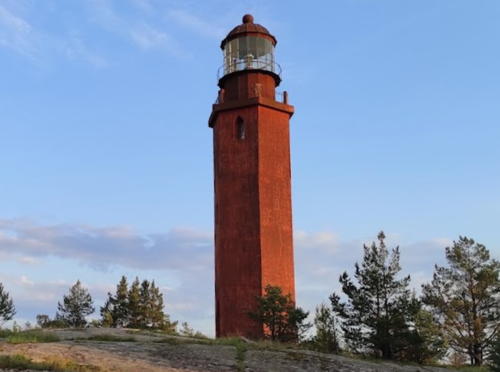Russia (Россия, Rossiya in Russian) is by far the world's largest country, spanning a little over 150° in longitude. It is organized as the Russian Federation (Rossiyskaya Federatsiya) with members known as federal subjects (sub'yekty federatsii). Russia is primarily a continental nation but it has important coastlines on the Baltic, Black, and Caspian Seas and very long coastlines on the Arctic Ocean and North Pacific Oceans. To guard these coasts it operates hundreds of lighthouses, many of them historic.
The Gulf of Finland, the eastern arm of the Baltic Sea, extends about 425 km (265 mi) to end at St. Petersburg, Russia's traditional western outlet to the sea. For most of its length the Gulf is 60-120 km (38-75 mi) wide. The eastern quarter of the Gulf's length is surrounded by Russian territory and the western 3/4 separates Finland on the north from Estonia on the south. Finland and Estonia were both parts of the Russian Empire before World War I and Estonia was a member republic of the Soviet Union from 1940 until 1991.
The region on the south side of the Gulf between St. Petersburg and the Estonian border is known as Ingria (Inkeri in Finnish, Ingermanland in Swedish). Ingria has been part of Russia since it was conquered by Peter the Great in the early 1700s. Today Ingria represents a large part of Russia's Leningrad Oblast (province), one of the federal subjects. Leningrad Oblast is divided into 17 districts (raions) and one city district (gorodskoy okrug). This page covers the Kingisepp and Lomonosov Districts and the Sosnovy Bor City District.
Curly braces {} are used to enclose former Finnish names of some of the light stations in the Gulf of Finland region that were controlled by Finland between the two world wars.
The Russian word for a lighthouse is mayak (маяк); ostrov is an island, rif is a reef, mys is a cape, bukhta is a bay, zaliv is a larger bay or gulf, proliv is a strait, reka is a river, and gavan' is a harbor.
Russian lighthouses are owned by the Russian Navy and maintained by the Office of Navigation and Oceanography (Управление навигации и океанографии).
ARLHS numbers are from the ARLHS World List of Lights. Admiralty numbers are from volume C of the Admiralty List of Lights & Fog Signals. U.S. NGA List numbers are from Publication 116.
- General Sources
- Online List of Lights - Russia - Baltic Sea
- Photos by various photographers posted by Alexander Trabas. Photos of the Gulf islands lights are by Capt. Peter Mosselberger.
- World of Lighthouses - Russia - Baltic Sea and Gulf of Finland
- Photos by various photographers available from Lightphotos.net.
- Lighthouses in Leningrad Oblast
- Photos by various photographers available from Wikimedia.
- Russische Leuchttürme auf historischen Postkarten
- Postcard views of historic Russian lighthouses posted by Klaus Huelse.
- i-Boating Charts
- Navigation chart for the Gulf of Finland.

Gogland (Pohjoiskorkia) Light,
July 2010
Wikimedia Creative Commons photo
by Alexey Krasovsky









